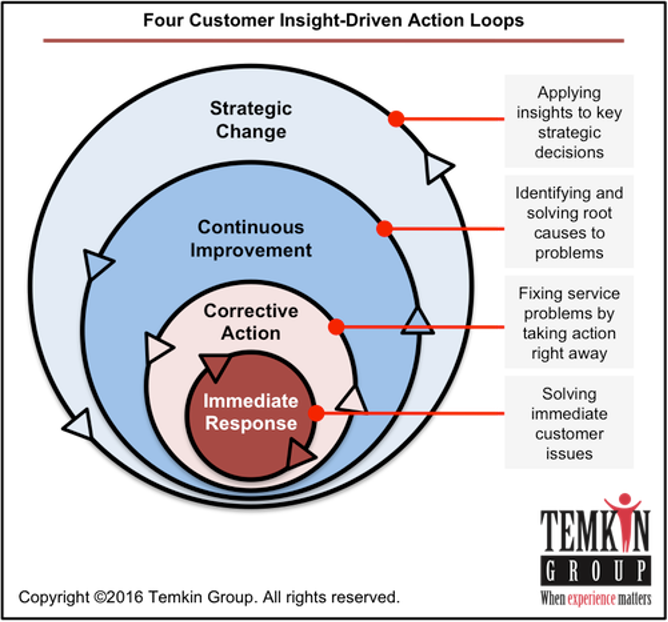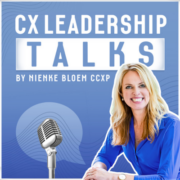CX Framework series #3: Experience design, improvement & innovation
How to shape your CX design & change process
Once you have determined what your Customer Experience strategy should look like and you have good Customer Understanding you will need to need to shape your CX design: having clear repeatable processes and frameworks in place to design the customer experience you want to deliver or redesign the one you are currently offering. To do so, you can use at least three frameworks, not necessarily in this order.
1. Customer Journey Mapping and Customer Journey Thinking
To actively influence your customers’ decision process when buying a product or ordering a service, you need to know which path they are walking, at which moments they are making decisions and how you are interacting with them at each moment along the way. The most common tool used for this is “Customer Journey Mapping” and the most deep and effective way is to propel also a wider “Customer Journey Thinking”. To do so, the Temkin Group recommends that organizations teach employees to consistently think about the following five questions:
- Who is the customer? For which persona is this map? This is a great place to use personas as a mechanism for describing the customer
- What is the customer’s real goal? What is he/she trying to accomplish by reaching out to you?
- What did the customer do just before reaching out? What did he/she do independently and which struggles did he/she encounter?
- What will the customer do right after contacting you? What do you need the customer to do so he/she can accomplish his/her goal?
- What will make the customer happy? Go above and beyond the initial question and deliver a customer experience that will exceed expectations.
And don’t forget to include partners and external suppliers in your map. Although they are not part of the core team in your company, they are in contact with your customers and have an impact on your company’s image. They represent your Customer Experience ecosystem (Forrester).
An example from our own life: An undertaker organised a very respectful and beautiful service for a beloved one, but the coffee that was served following the service was just awful. When the people attending the funeral service complained about the quality of the coffee, his response was: “It’s not my fault, my catering partner provides the beverages.” In terms of customer experience, this response is not acceptable because your customers are not interested in how you organised these things. They want a ‘good service’ at the funeral and it is the undertaker’s responsibility to organise this in cooperation with all his partners.
One simple way to get started with Customer Journey Mapping is to follow the 6 steps methodology by Conexperience involving into the workshop not only your employees, but also other key players of your ecosystem.
2. ‘Innovation through Design Thinking’ and ‘Service design thinking’
Design thinking is created because big corporations lack the ability to be creative and aren’t able to create new products and services that meet unfulfilled needs of their customers.
Design thinking is a methodology, but it’s also about a mindset and about a changing paradigm in management theory, moving from the traditional top‐down and quantitative approach to a more bottom‐up, qualitative approach in innovation processes.
It builds around 5 principles.
Service design is about making what you do more useful, usable & desirable for your users, and more efficient, effective & valuable for you ‐ everyone loves a great experience
Innovation is part of your organization at any time. So if you see that there are a lot of complaints about a feature, product or service, you can take the lead and innovate the bottleneck point of the process. When doing this, make sure you follow a “Double-Diamond Design” process:
- Research the exact problem, both from the customer’s perspective as from that of your employees.
- Then analyse these results and create artefacts (like a customer journey map) to make a visual representation of the problem.
- When you have these insights, start a group session to generate ideas on how to resolve the problem.
- Make a prototype and perform some testing.
- Then you continue to receive feedback and continue to improve the prototype, until…
- You have a final product or service you can fully implement.
3. Continuous Improvement based on customer insight
Temkin Group identifies four customer insight-driven action loops. These can be aggregated in two big areas of action, which have gained different naming in the field:
- Fire-Fighting (also called small loop, inner loop, customer loop or case management): this is about ad-hoc immediate follow-up on each survey response and includes:
- Immediate Response towards customers on a 121 basis or Collectively, via dedicated & targeted communication or as open communication on digital channels
- Corrective/Celebration Action internally: i.e. providing immediate feedback towards employees or making quick adjustments.
- Fire-Prevention (also called big loop, outer loop, business loop or action planning): this is about driving structural changes and improvements based on the insight gained from NPS responses over-time, and encompasses:
- Continuous and/or Structural Improvement
- to address root causes behind drivers of detraction
- to identify ways to WOW customers based on their needs to move them from passives to promoters
- to keep and intensify doing the identified drivers of promotion
- Strategic Change: the new insight gained from customers’ voice about what really matters to them can be so substantial to fully influence small or big strategy changes.
- Continuous and/or Structural Improvement

You can read more details about these 4 loops and why they are so important to drive change in WHY NPS as Measurement and Methodology: which goals does it serve?
When it comes to change and innovation from the customer experience perspective it is all about Acting. It is about looking to your processes, products and service through the eyes of your customer and adjust, continuously.
Want to grow your Customer Experience competences?
These are only some of the highlights Milou took away from attending the Customer Experience Masterclass. Would you like to know more? Join our next CX Masterclass.
Customer Experience Framework and complete list of blog posts in this series
This post is part of a wider series about all the 6 CX disciplines that represent the CXPA Framework around which the CCXP exam is structured and that we cover in the CX Masterclass.
Find here the complete list of the other posts in this series:
- CX Strategy
- Customer Understanding
- Design, Improvement and Innovation
- Measurement
- Governance
- Culture
Extra: CXPA exam & Becoming CCXP (will be published on the 11th of December)
About this series
This post is part of the CX Framework series by Rosaria Cirillo and Nienke Bloem.
The foundations for these blogposts are written by Milou van Kerkhof following the June 2017 CX Masterclass given by Nienke Bloem and Rosaria Cirillo. Milou attended this as a newcomer in Customer Experience. These blogposts have been slightly edited and reflect only the highlights of the content of each module
*****
Nienke Bloem is often called the Customer Experience speaker in the blue dress.
She’s a global CX thought leader, educator and a global keynote speaker who inspires audiences with best practices and proven methodologies. She leads a speaking practice, a CX game company and a training business; she breathes Customer Experiences and is author of two CX books.
Her two-day Customer Experience Masterclass is known as the best program to prepare for your CCXP and she is the go-to person voor CX leaders who want to advance their leadership and bring direct results from their Customer Experience transformation programs. Since 2020, she hosts a CX Leadership Masterminds program and helps leaders spice up their leadership and deliver an engaging CX Story including a solid CX Strategy. Besides, she is a modern-day pilgrim and found the parallel with leading customer centric transformations.
With her over 20 years corporate experience, she speaks the business language. Her keynotes and education programs in Customer Experience are inspiring and hands-on. She is one of the few Recognized Training Partners of the CXPA and it is her mission to Make Customer Experience Work and help you deliver business results.








